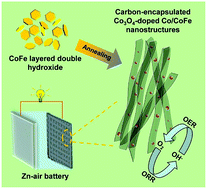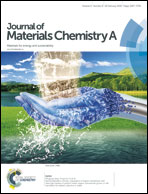Co3O4-doped Co/CoFe nanoparticles encapsulated in carbon shells as bifunctional electrocatalysts for rechargeable Zn–Air batteries†
Abstract
The development of catalysts based on non-precious metals that are able to catalyze both the oxygen reduction and oxygen evolution reactions (ORR/OER) is the key element to promote the practical application of rechargeable metal–air batteries. Here we report a novel concept that layered double hydroxides (LDHs) can be used as a precursor to form bimetals and their oxides simultaneously. Co3O4-doped Co/CoFe nanoparticles integrated with graphitic shells are derived from the thermal decomposition of a CoFe LDH bonded with urea as the carbon precursor. The composite material shows a surprisingly high bifunctional (ORR/OER) catalytic activity. The realized core–shell structure synergistically promotes the ORR performance while cobalt oxide doped on the metal surface boosts the OER performance. In addition, the carbon shell ensures high electrical conductivity and effectively impedes the aggregation and the further oxidation of Co/CoFe nanoparticles. When integrating the catalyst into a rechargeable Zn–air battery, the battery performance shows a higher discharge potential and cycling stability (over 65 h of cycling) and a lower charge plateau compared with a Zn–air battery based on a Pt/C and RuO2 catalyst mixture. This work demonstrates a new efficient air cathode material which could be practically applied to rechargeable metal–air batteries or other fuel cells.



 Please wait while we load your content...
Please wait while we load your content...